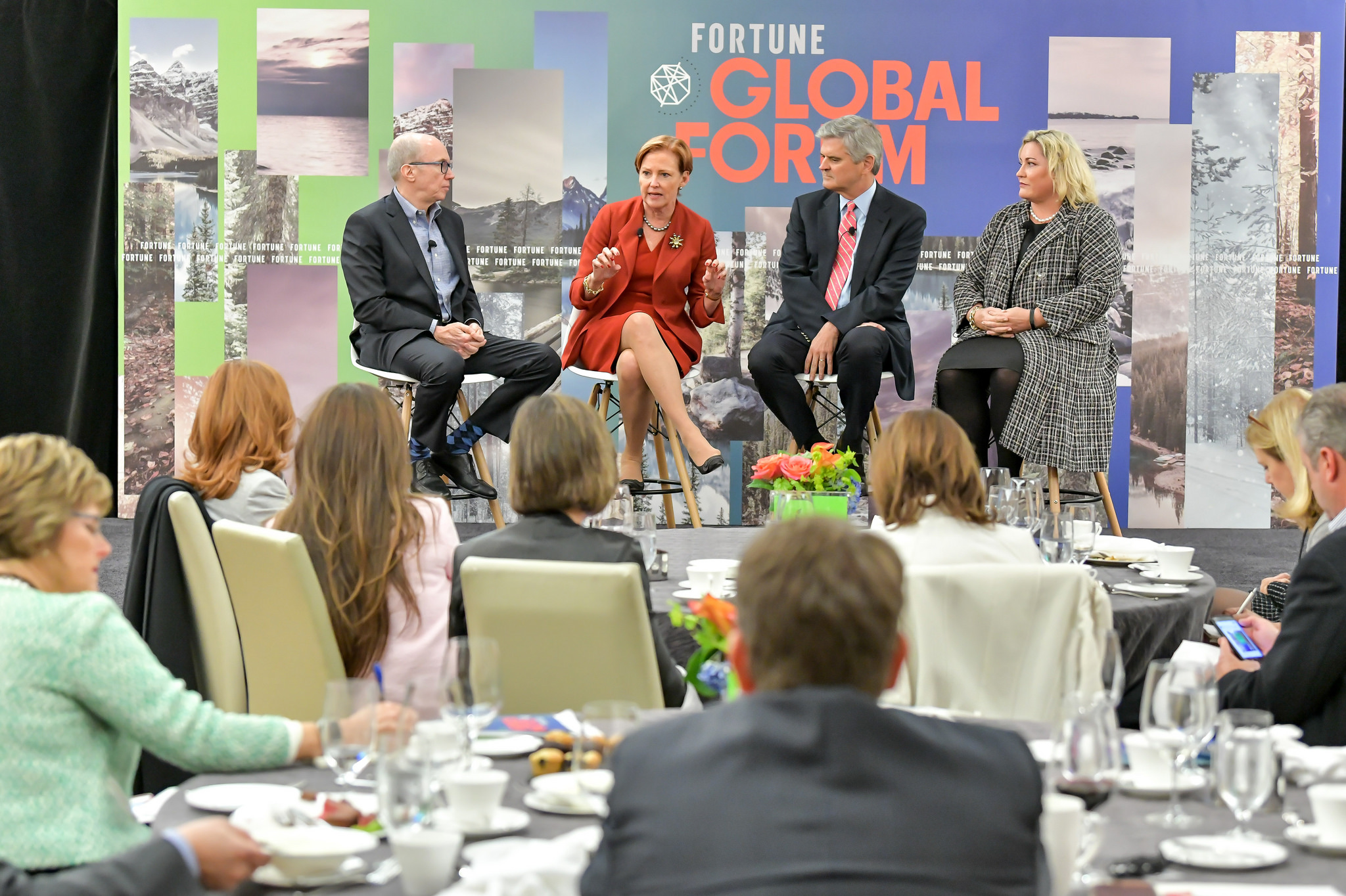
|
如果想打造創(chuàng)新文化,,就不能再繼續(xù)捧著那些曾經(jīng)創(chuàng)造輝煌的人和產(chǎn)品不放了——大公司尤其如此,。有明確的公司使命,也能對創(chuàng)新有所幫助,。 這是2018年加拿大多倫多財(cái)富全球論壇上的一些重要結(jié)論,。在論壇的一個環(huán)節(jié)中,三位現(xiàn)任和離任CEO熱烈討論了這一議題:大公司的設(shè)計(jì)旨在求穩(wěn),,而非通過創(chuàng)新開拓新市場。 杜邦前任總裁兼CEO柯愛倫拋出問題:“你如何看待失???如何從失敗中學(xué)習(xí)怎么做得更好?” Revolution公司的總裁兼CEO史蒂夫·凱斯沉吟片刻,,回憶了他掌管美國在線(AOL)時公司2000年以1650億美元傳奇般地收購了時代華納之后的經(jīng)歷,。時至今日,這仍然是史上最大規(guī)模的并購,,然而,,“現(xiàn)在也是史上最失敗的并購,這事會刻進(jìn)我的墓志銘,?!彼f。 他將失敗歸咎于文化沖突,,并購后這個數(shù)字行業(yè)的初創(chuàng)企業(yè)慢慢變成了一家要保護(hù)傳統(tǒng)資產(chǎn)的大型媒體公司,?!皠?chuàng)業(yè)家思維是‘攻占山頭’,”他說,?!暗诓①徍螅乙庾R到[被收購的公司]思維方式不同,他們更關(guān)注短期表現(xiàn),、避免犯錯,而當(dāng)今世界最大的錯誤就是不敢冒險,。” “當(dāng)你需要保持現(xiàn)有產(chǎn)品增長,,維持穩(wěn)定收入時,,的確會產(chǎn)生惰性,?!卑雽?dǎo)體初創(chuàng)企業(yè)Ampere Computing的總裁兼CEO詹睿妮說。但這位前英特爾總裁表示,,如果小團(tuán)隊(duì)得到了合適的投資,,會自然而然地追求更宏大的愿景,,他們可以打破這種僵化的局面,?!坝忻鞔_的公司使命對于創(chuàng)新十分重要,”她說,?!澳阆虢鉀Q什么問題,?你想如何改變世界,?” 她開玩笑說,,零食確實(shí)能激勵團(tuán)隊(duì),,但是,,讓公司上下團(tuán)結(jié)一致,不斷嘗試,,取得成果才是關(guān)鍵所在,。 “要打造明確的企業(yè)文化,[宣布]目標(biāo),,確定衡量指標(biāo),,”詹睿妮說,?!白尮旧仙舷孪露贾牢覀兿胍獙?shí)現(xiàn)什么,?!边@樣,每個人的福利都取決于每一季度的工作成果,,清清楚楚,。“每個人都將因?yàn)槟莻€[目標(biāo)]得到回報,?!?/p> 柯愛倫分享了杜邦早期面臨的生死存亡危機(jī),那時還是20世紀(jì)20年代,。 “我們最初是家炸藥公司,。我們還是家龐大而僵化的公司?!彼f。為了推動創(chuàng)新,他們聘用了20世紀(jì)20年代版本的千禧一代,,他們詢問這些從事銷售和市場營銷的年輕人,,杜邦應(yīng)當(dāng)如何擁抱新的機(jī)遇,因?yàn)檫@些年輕人了解正在變化的市場,。這個年輕的團(tuán)隊(duì)將杜邦重新定義為矩陣式結(jié)構(gòu)組織,,避免人們在原有工作流程下,新想法還沒有擺到董事會的桌上就已經(jīng)被扼殺了,。該團(tuán)隊(duì)還在組織內(nèi)部實(shí)現(xiàn)了創(chuàng)新責(zé)任的重新分布,。“從此之后,,我們在每一個曾經(jīng)經(jīng)營的業(yè)務(wù)領(lǐng)域都進(jìn)行發(fā)明,,創(chuàng)造了新的產(chǎn)品類別?!彼f,。“我們要不斷發(fā)明,,不然就會被淘汰,。” 在Revolution公司,,凱斯正在全國范圍內(nèi)尋找具有創(chuàng)新精神的創(chuàng)業(yè)公司,,尤其是在傳統(tǒng)投資領(lǐng)域覆蓋范圍之外的公司,;尋找在合適的條件下可以與大公司開展合作的創(chuàng)業(yè)公司,。 對于這些公司而言,資金是個問題,?!叭ツ?5%的風(fēng)投資金流向了三個州,加州,、紐約和馬薩諸塞州,。但并非所有高增長的創(chuàng)業(yè)公司都在那里?!彼f,。 所有人都認(rèn)同文化變革必須是刻意為之的重塑過程?!半S著公司規(guī)模變大,,那些小嘗試就不復(fù)存在了?!眲P斯說,。 為了找回那些小嘗試,,你要確保人們已經(jīng)準(zhǔn)備好采取不一樣的運(yùn)營模式了?!捌髽I(yè)的文化模式和文化圖騰源自企業(yè)內(nèi)部,,”柯愛倫說?!耙屩袑宇I(lǐng)導(dǎo)對跳出舒適圈感到習(xí)慣,,這必須要成為企業(yè)文化的一部分?!保ㄘ?cái)富中文網(wǎng)) 譯者:Agatha |
If you want to build a culture of innovation, you’re going to have to stop protecting the people and products that once made you great—especially if you’re a big company. Having a mission also helps. These are some of the big takeaways from the Fortune Global Forum 2018 in Toronto, Canada, as three current and former CEOs wrestled with the notion that big companies are more designed to play it safe, rather than innovate their way into new markets. “How do you honor failures and use those as learning tools to figure out how to do better?” asked Ellen Kullman, the former Chairman and CEO of DuPont. Steve Case, the Chairman and CEO of Revolution, took a moment to look reflect on his experience at the helm of AOL after their storied purchase of Time Warner for $165 billion in 2000. It remains the biggest merger in history, and yet, “now, the worst merger in history, which will go on my tombstone,” he says. He blames a culture clash as the digital start-up morphed into a massive media company with traditional assets to protect. “The entrepreneurial mindset is ‘take the hill,’” he said. “After the merger, I just realized there’s a different mindset [in the merged firm], much more about the short-term and avoiding mistakes, in a world where the biggest mistake is not taking enough risks.” “There’s a real inertia when you need to keep existing product growing and revenue stable,” says Renee James, Chairman and CEO of semiconductor start-up, Ampere Computing. But the former Intel president says that small teams, properly invested in, naturally respond to a big vision and can break the gridlock. “Mission is a big deal in innovation,” she says. “What problem do you want to solve? How do you want to change the world?” While snacks clearly help keep teams energized, she joked, aligning the entire company to the outcome of the experimental work is the real key, she says. We create a culture of clarity, [declare] a goal and say how we’re going to measure it,” says James. “And the whole company knows what we’re trying to do.” Then, everyone’s bonus is linked to four clear deliverables, reviewed every quarter. “Everyone is going to get paid on that [goal].” Kulman shared one of DuPont’s earliest grow or die moments—in the 1920s. “We began as an explosives company. We were also a monolithic organization,” she says. To create an innovation pipeline, they tapped the 1920s version of millennials, the young people in sales and marketing who understood the changing marketplace and asked them how DuPont could respond to new opportunities. The team reimagined DuPont as a matrix organization which helped people work around the processes that were killing ideas before they were ever considered for investment by the board. It also helped re-distribute the responsibility for innovation throughout the organization. “We’ve since invented every category we’ve operated in,” she says. “We have to keep inventing or we’re not going to be around.” At Revolution, Case is now seeking innovative start-ups across the country, in communities firmly outside of traditional venture circles; the types of companies that, under the right circumstances, could be a partner of a larger firm. For these companies, cash is the problem. “Seventy-five percent of venture capital went to three states last year, California, New York, and Massachusetts. Not every high growth start-up is there,” he says. All agree that culture change has to be an intentional act of reinvention. “As companies get bigger, the little experiments go away,” says Case. To bring them back, you’ll have to make sure people are ready to operate differently. “Culture norms, totems, are set in the middle of the company,” says Kullman. “Making sure those middle leaders are comfortable with the uncomfortable has to become part of the culture.” |






